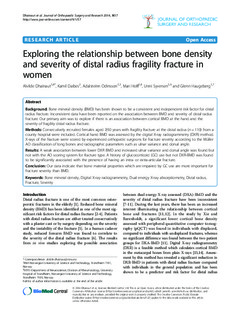| dc.contributor.author | Dhainaut, Alvilde | |
| dc.contributor.author | Daibes, Kamil | |
| dc.contributor.author | Odinsson, Adalstein | |
| dc.contributor.author | Hoff, Mari | |
| dc.contributor.author | Syversen, Unni | |
| dc.contributor.author | Haugeberg, Glenn | |
| dc.date.accessioned | 2019-11-08T07:42:47Z | |
| dc.date.available | 2019-11-08T07:42:47Z | |
| dc.date.created | 2014-10-29T13:23:06Z | |
| dc.date.issued | 2014 | |
| dc.identifier.issn | 1749-799X | |
| dc.identifier.uri | http://hdl.handle.net/11250/2627276 | |
| dc.description.abstract | Background
Bone mineral density (BMD) has been shown to be a consistent and independent risk factor for distal radius fracture. Inconsistent data have been reported on the association between BMD and severity of distal radius fracture. Our primary aim was to explore if there is an association between cortical BMD at the hand and the severity of fragility distal radius fracture.
Methods
Consecutively recruited females aged ≥50 years with fragility fracture at the distal radius (n = 110) from a county hospital were included. Cortical hand BMD was assessed by the digital X-ray radiogrammetry (DXR) method. X-rays of the fracture were scored by experienced orthopedic surgeons for fracture severity according to the Müller AO classification of long bones and radiographic parameters such as ulnar variance and dorsal angle.
Results
A weak association between lower DXR BMD and increased ulnar variance and dorsal angle was found but not with the AO scoring system for fracture type. A history of glucocorticoid (GC) use but not DXR-BMD was found to be significantly associated with the presence of having an intra- or extra-articular fracture.
Conclusion
Our data indicate that bone material properties which are impaired by GC use are more important for fracture severity than BMD. | nb_NO |
| dc.language.iso | eng | nb_NO |
| dc.publisher | BMC (part of Springer Nature) | nb_NO |
| dc.rights | Navngivelse 4.0 Internasjonal | * |
| dc.rights.uri | http://creativecommons.org/licenses/by/4.0/deed.no | * |
| dc.title | Exploring the relationship between bone density and severity of distal radius fragility fracture in women | nb_NO |
| dc.type | Journal article | nb_NO |
| dc.type | Peer reviewed | nb_NO |
| dc.description.version | publishedVersion | nb_NO |
| dc.source.volume | 9 | nb_NO |
| dc.source.journal | Journal of Orthopaedic Surgery and Research | nb_NO |
| dc.source.issue | 1 | nb_NO |
| dc.identifier.doi | 10.1186/s13018-014-0057-8 | |
| dc.identifier.cristin | 1168046 | |
| dc.description.localcode | © 2014 Dhainaut et al.; licensee BioMed Central Ltd. This is an Open Access article distributed under the terms of the Creative Commons Attribution License (http://creativecommons.org/licenses/by/4.0), which permits unrestricted use, distribution, and reproduction in any medium, provided the original work is properly credited. The Creative Commons Public Domain Dedication waiver (http://creativecommons.org/publicdomain/zero/1.0/) applies to the data made available in this article, unless otherwise stated. | nb_NO |
| cristin.unitcode | 1920,9,0,0 | |
| cristin.unitcode | 194,65,30,0 | |
| cristin.unitcode | 1920,15,0,0 | |
| cristin.unitcode | 194,65,15,0 | |
| cristin.unitname | Klinikk for ortopedi, revmatologi og hudsykdommer | |
| cristin.unitname | Institutt for nevromedisin og bevegelsesvitenskap | |
| cristin.unitname | Medisinsk klinikk | |
| cristin.unitname | Institutt for klinisk og molekylær medisin | |
| cristin.ispublished | true | |
| cristin.fulltext | original | |
| cristin.qualitycode | 1 | |

